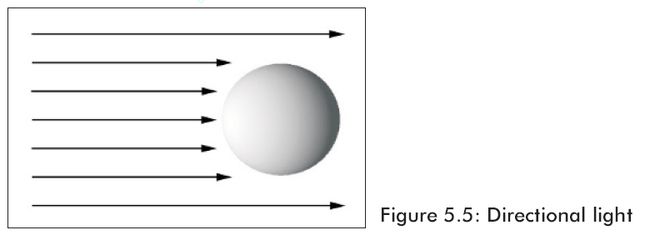D3D中的光照(2)
5.4光源
Direct3D支持三种类型的光源。
点光源——这种光源在世界坐标中有一个位置且向所有方向上都照射光线。
方向光源——这种光源没有位置但是向指定方向发出平行光线。
聚光灯——这种类型的光源和手电筒的光类似;它有位置并且发出的光在指定方向上按照圆锥形照射。这个圆锥形有两个角度,θ和φ。角度θ描述内圆锥,φ描述外圆锥。
在代码中一个灯光资源是通过D3DLIGHT9结构来表现的。
D3DLIGHTTYPE Type;
D3DCOLORVALUE Diffuse;
D3DCOLORVALUE Specular;
D3DCOLORVALUE Ambient;
D3DVECTOR Position;
D3DVECTOR Direction;
float Range;
float Falloff;
float Attenuation0;
float Attenuation1;
float Attenuation2;
float Theta;
float Phi;
} D3DLIGHT9;
Type——定义灯光类型,我们能够使用下面三种类型之一:D3DLIGHT_POINT, D3DLIGHT_SPOT, D3DLIGHT_DIRECTIONAL
Diffuse——此光源发出的漫射光颜色。
Specular——此光源发出的镜面光颜色。
Ambient——此光源发出的环境光颜色。
Position——用一个向量来描述的光源世界坐标位置。这个值对于灯光的方向是无意义的。
Direction——用一个向量来描述的光源世界坐标照射方向。这个值不能用在点光源上。
Range——灯光能够传播的最大范围。这个值不能比![]() 大。且不能用于方向光源。
大。且不能用于方向光源。
Attenuation0, Attenuation1, Attenuation2——这些衰减变量被用来定义灯光强度的传播距离衰减。它们只被用于点光源和聚光灯上。Attenuation0定义恒定衰减,Attenuation1定义线性衰减,Attenuation2定义二次衰减。适当的使用这个公式,D是代表到光源的距离,A0,A1,A2与Attenuation0,1,2相匹配。
attenuation = 1/(A0 + A1D + A2D2)
Theta——只用于聚光灯;指定内圆锥的角度,单位是弧度。
Phi——只用于聚光灯;指定外圆锥的角度,单位是弧度。
现在只是演示怎样使用InitDirectionalLight。其他的也很类似:
创建一个方向光源,它沿着x轴正方向照射白色灯光。我们按照下面的方法来做:
| D3DXVECTOR3 dir(1.0f, 0.0f, 0.0f); D3DXCOLOR c = d3d::WHITE; D3DLIGHT9 dirLight = d3d::InitDirectionalLight(&dir, &c); |
在把D3DLIGHT9初始化好以后,我们需要用Direct3D内在支持的灯光来注册。就象这样做:
| Device->SetLight( 0, // element in the light list to set, range is 0-maxlights &light);// address of the D3DLIGHT9 structure to set |
一旦灯光注册了,我们就能使用下面的列举的例子来开或关灯光了:
| Device->LightEnable( 0, // the element in the light list to enable/disable true); // true = enable, false = disable |
5.5实例程序:灯光
这一章的例子是创建如图5.7所显示的场景。它示范了怎样指定顶点法线,怎样创建材质,以及怎样创建和使用一个方向灯光。注意在这个示例程序中我们不会使用在文件d3dUtility.h/cpp中的材质和灯光函数。因为我们想展示怎样手动来做这些设置。
图5.7
给场景增加灯光的步骤是:
1、 允许使用灯光。
2、 为每个物体创建材质并且在渲染相应物体前应将材质附予物体。
3、 创建一个或多个光源,设置它们,把它们设为可用。
4、 将其他附加光源设为可用,比如镜面高光。
Renders a light pyramid. Demonstrates how to specify the vertex normals, how to create
and set a material, and how to create and set a directional light.
************************************************************************************* */
#include " d3dUtility.h "
#pragma warning(disable : 4100 )
class cLightVertex
{
public :
float m_x, m_y, m_z;
float m_nx, m_ny, m_nz;
cLightVertex() {}
cLightVertex( float x, float y, float z, float nx, float ny, float nz)
{
m_x = x; m_y = y; m_z = z;
m_nx = nx; m_ny = ny; m_nz = nz;
}
};
const DWORD LIGHT_VERTEX_FVF = D3DFVF_XYZ | D3DFVF_NORMAL;
/////////////////////////////////////////////////////////////////////////////////////////////////// /
const int WIDTH = 640 ;
const int HEIGHT = 480 ;
IDirect3DDevice9 * g_d3d_device = NULL;
IDirect3DVertexBuffer9 * g_pyramid_vb = NULL;
/////////////////////////////////////////////////////////////////////////////////////////////////// /
bool setup()
{
// turn on lighting
g_d3d_device -> SetRenderState(D3DRS_LIGHTING, TRUE);
g_d3d_device -> CreateVertexBuffer( 12 * sizeof (cLightVertex), D3DUSAGE_WRITEONLY, LIGHT_VERTEX_FVF,
D3DPOOL_MANAGED, & g_pyramid_vb, NULL);
// fill the buffers with the triangle data
cLightVertex * vertices;
g_pyramid_vb -> Lock( 0 , 0 , ( void ** ) & vertices, 0 );
// front face
vertices[ 0 ] = cLightVertex( - 1.0f , 0.0f , - 1.0f , 0.0f , 0.707f , - 0.707f );
vertices[ 1 ] = cLightVertex( 0.0f , 1.0f , 0.0f , 0.0f , 0.707f , - 0.707f );
vertices[ 2 ] = cLightVertex( 1.0f , 0.0f , - 1.0f , 0.0f , 0.707f , - 0.707f );
// left face
vertices[ 3 ] = cLightVertex( - 1.0f , 0.0f , 1.0f , - 0.707f , 0.707f , 0.0f );
vertices[ 4 ] = cLightVertex( 0.0f , 1.0f , 0.0f , - 0.707f , 0.707f , 0.0f );
vertices[ 5 ] = cLightVertex( - 1.0f , 0.0f , - 1.0f , - 0.707f , 0.707f , 0.0f );
// right face
vertices[ 6 ] = cLightVertex( 1.0f , 0.0f , - 1.0f , 0.707f , 0.707f , 0.0f );
vertices[ 7 ] = cLightVertex( 0.0f , 1.0f , 0.0f , 0.707f , 0.707f , 0.0f );
vertices[ 8 ] = cLightVertex( 1.0f , 0.0f , 1.0f , 0.707f , 0.707f , 0.0f );
// back face
vertices[ 9 ] = cLightVertex( 1.0f , 0.0f , 1.0f , 0.0f , 0.707f , 0.707f );
vertices[ 10 ] = cLightVertex( 0.0f , 1.0f , 0.0f , 0.0f , 0.707f , 0.707f );
vertices[ 11 ] = cLightVertex( - 1.0f , 0.0f , 1.0f , 0.0f , 0.707f , 0.707f );
g_pyramid_vb -> Unlock();
// create and set the material
D3DMATERIAL9 material;
material.Ambient = WHITE;
material.Diffuse = WHITE;
material.Specular = WHITE;
material.Emissive = BLACK;
material.Power = 5.0f ;
g_d3d_device -> SetMaterial( & material);
// setup a directional light
D3DLIGHT9 dir_light;
ZeroMemory( & dir_light, sizeof (dir_light));
dir_light.Type = D3DLIGHT_DIRECTIONAL;
dir_light.Diffuse = WHITE;
dir_light.Specular = WHITE * 0.3f ;
dir_light.Ambient = WHITE * 0.3f ;
dir_light.Direction = D3DXVECTOR3( 1.0f , 0.0f , 0.0f );
// set and enable the light
g_d3d_device -> SetLight( 0 , & dir_light);
g_d3d_device -> LightEnable( 0 , TRUE);
// turn on specular lighting and instruct Direct3D to renormalize normals
g_d3d_device -> SetRenderState(D3DRS_NORMALIZENORMALS, TRUE);
g_d3d_device -> SetRenderState(D3DRS_SPECULARENABLE, TRUE);
// position and aim the camera
D3DXMATRIX view_matrix;
D3DXVECTOR3 pos( 0.0f , 1.0f , - 3.0f );
D3DXVECTOR3 target( 0.0f , 0.0f , 0.0f );
D3DXVECTOR3 up( 0.0f , 1.0f , 0.0f );
D3DXMatrixLookAtLH( & view_matrix, & pos, & target, & up);
g_d3d_device -> SetTransform(D3DTS_VIEW, & view_matrix);
// set the projection matrix
D3DXMATRIX proj;
D3DXMatrixPerspectiveFovLH( & proj, D3DX_PI * 0.5f , ( float )WIDTH / HEIGHT, 1.0f , 1000.0f );
g_d3d_device -> SetTransform(D3DTS_PROJECTION, & proj);
return true ;
}
void cleanup()
{
safe_release < IDirect3DVertexBuffer9 *> (g_pyramid_vb);
}
bool display( float time_delta)
{
// update the scene: rotate the pyramid
D3DXMATRIX y_rot;
static float y = 0.0f ;
D3DXMatrixRotationY( & y_rot, y);
y += time_delta;
if (y >= 6.28f )
y = 0.0f ;
g_d3d_device -> SetTransform(D3DTS_WORLD, & y_rot);
// draw the scene
g_d3d_device -> Clear( 0 , NULL, D3DCLEAR_TARGET | D3DCLEAR_ZBUFFER, 0x00000000 , 1.0f , 0 );
g_d3d_device -> BeginScene();
g_d3d_device -> SetStreamSource( 0 , g_pyramid_vb, 0 , sizeof (cLightVertex));
g_d3d_device -> SetFVF(LIGHT_VERTEX_FVF);
g_d3d_device -> DrawPrimitive(D3DPT_TRIANGLELIST, 0 , 4 );
g_d3d_device -> EndScene();
g_d3d_device -> Present(NULL, NULL, NULL, NULL);
return true ;
}
LRESULT CALLBACK wnd_proc(HWND hwnd, UINT msg, WPARAM word_param, LPARAM long_param)
{
switch (msg)
{
case WM_DESTROY:
PostQuitMessage( 0 );
break ;
case WM_KEYDOWN:
if (word_param == VK_ESCAPE)
DestroyWindow(hwnd);
break ;
}
return DefWindowProc(hwnd, msg, word_param, long_param);
}
int WINAPI WinMain(HINSTANCE inst, HINSTANCE, PSTR cmd_line, int cmd_show)
{
if ( ! init_d3d(inst, WIDTH, HEIGHT, true , D3DDEVTYPE_HAL, & g_d3d_device))
{
MessageBox(NULL, " init_d3d() - failed. " , 0 , MB_OK);
return 0 ;
}
if ( ! setup())
{
MessageBox(NULL, " Steup() - failed. " , 0 , MB_OK);
return 0 ;
}
enter_msg_loop(display);
cleanup();
g_d3d_device -> Release();
return 0 ;
}
Setup函数给场景加入灯光。首先允许使用灯光,当然这不是必须的因为默认设置就是允许使用灯光的。
下一步,我们创建顶点缓存,锁定,并且把“金字塔”的三角形顶点放入其中。顶点法线是利用5.3节中的运算法则预先计算好的。注意三角形共享顶点,但它们的法线不能共享;因此对这个物体使用索引列表并不是最有利的。例如,所有三角形都共享顶点(0,1,0);然而,对每个三角形,它们的顶点法线是不相同的。
为物体产生了顶点数据以后,我们描述利用灯光表现各自材质的物体间是怎样相互影响的。在这个例子中,“金字塔”反射出白光,自身不发光,且会产生一些高光。
接着,我们创建一个方向光并将其设为可用。方向光是沿着x轴的正方向照射的。灯光照射最强的白色漫射光(dir.Diffuse = WHITE),较弱的白色镜面光(dir.Specular = WHITE * 0.3f)以及一个中等强度的白色环境光(dir.Ambient = WHITE *0.6f)。
最后,我们设置状态使法线重新单位化且把镜面高光设置为可用。
下载源程序



